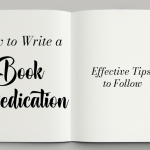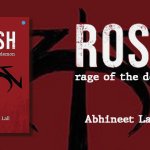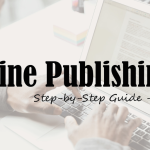Self-publishing an eBook in the digital era has become a feasible and powerful alternative for writers looking to share their work with a worldwide audience. The conventional publishing environment has transformed as a result of the emergence of online platforms and eBook readers, allowing writers to take control of their publication path. This detailed tutorial will help you through the process of self-publishing an eBook step by step and give vital insights into effectively selling it online.
- Getting Started with Self-Publishing
- Choosing the Right eBook Publishing Platform
- Designing an Eye-Catching Cover
- Formatting Your eBook
- Setting the Right Price
- Crafting an Engaging Book Description
- Marketing and Promoting Your eBook
- Monitoring and Adapting Your Strategy
- Navigating Challenges and Celebrating Success
- Staying Informed and Adapting to Trendsr
Getting Started with Self-Publishing
- Define Your Goals and Audience:
Take the time to establish your goals and determine your target audience before going on the process of self-publishing your eBook. Your objectives might range from sharing a personal tale to offering useful information on a certain issue. Understanding the aim of your eBook can help you write it and create your overall approach.
It is also critical to identify your target audience. Think about who might benefit or appreciate your eBook. Tailoring your material to their demands will result in a more engaged readership. This fundamental stage influences your writing style, content organisation, and even the channels you use for distribution. Your compass will be clear goals and a defined audience throughout the whole self-publishing journey. - Polish Your Manuscript:
After you’ve determined your objectives and target audience, the next crucial step is to develop your text. Professional editing is required to ensure that your material is not just error-free but also intriguing and engaging.
A polished text not only improves the overall reading experience, but it also builds your author reputation. Readers are more willing to invest their time and money in a book that demonstrates a dedication to quality. Editing is more than just syntax and punctuation; it also includes enhancing the narrative flow, character development, and coherence. Whether you hire a professional editor or solicit comments from beta readers, this phase is essential in the quest of a successful eBook.
Choosing the Right eBook Publishing Platform
- Amazon Kindle Direct Publishing (KDP):
- Account Setup: To kickstart your self-publishing journey, establish an account on Amazon Kindle Direct Publishing (KDP). This user-friendly platform provides the tools necessary for bringing your eBook to a global audience. Account creation involves straightforward steps, including personal and banking details for royalty payments. Once your account is set up, you gain access to a dashboard that becomes the control center for managing your book’s presence on Kindle.
- Formatting: Adhering to KDP’s formatting guidelines is pivotal for presenting your eBook professionally on Kindle devices. These guidelines cover aspects like layout, font, and images, ensuring a seamless reading experience for your audience. Following these specifications guarantees that your eBook appears as intended across various Kindle devices, maintaining visual consistency. Proper formatting contributes to positive reviews and enhances your book’s marketability. KDP offers tools like Kindle Create to simplify the formatting process, allowing you to focus more on your content while ensuring a polished final product.
- Other Platforms:
Expand your eBook’s reach beyond Amazon by exploring additional platforms like Apple Books, Barnes & Noble Press, and Kobo.
- Apple Books: Apple’s platform provides a significant market share, particularly among users of Apple devices. To publish on Apple Books, create an iTunes Connect account. Adapting your manuscript to Apple’s requirements is essential, and Apple Books Author is a helpful tool for formatting.
- Kobo: Kobo Writing Life is Kobo’s self-publishing platform. By creating an account and following their guidelines, you can tap into Kobo’s international audience. Kobo accepts a variety of formats, granting flexibility in manuscript preparation.
- BlueRoseONE: BlueRoseONE has an online platform for you to get your work published. The website is user-friendly and has multiple templates that will help you streamline your work and get it on the internet world-wide.
You may also like: The Importance of Professional Editing in Self-Publishing
Designing an Eye-Catching Cover
- Importance of a Professional Cover:
- First Impressions: The adage “don’t judge a book by its cover” is often overlooked in the literary world because, in reality, readers do judge books by their covers. Your book’s cover serves as the initial point of contact between your work and potential readers. It’s the visual introduction to your narrative, influencing the decision to explore further. Investing time or resources in creating an appealing and professional design is a strategic move to ensure that the first impression is captivating and reflective of the quality within.
- Brand Consistency: Your book cover plays a crucial role in establishing brand consistency. It should align with the genre, tone, and themes of your book, effectively communicating its essence. Consistency in cover design across a series or within a genre helps readers recognize your brand and instills confidence. A well-designed cover sets expectations for the reading experience, making it an integral component of your book’s overall identity.
- Tools for Cover Design:
- Canva: Canva is a user-friendly and accessible tool for authors looking to create custom book covers. With a variety of templates, design elements, and an intuitive interface, Canva empowers authors, even those without graphic design expertise, to craft visually appealing covers. It’s a cost-effective solution for independent authors seeking professional-looking designs tailored to their vision.
- Professional Designers: For those aiming for a polished and unique cover that stands out in a competitive market, hiring a professional designer is a wise investment. Professional designers bring expertise, creativity, and an understanding of market trends to the table. They can translate your book’s essence into a visually compelling cover that not only attracts but also resonates with your target audience. While it involves a financial commitment, the impact of a professionally designed cover on book sales and reader perception is often well worth the cost.
You may also like: 7 Top Rated Self-Help Books of all time in 2024
Formatting Your eBook
- Consistent Formatting Matters:
- Readability: Ensuring optimal readability is paramount when self-publishing an eBook. Readers use various devices with different screen sizes, and your eBook should adapt seamlessly to this diversity. Proper formatting allows text and images to display correctly on devices ranging from eReaders to tablets and smartphones. A positive reading experience enhances reader satisfaction and reviews, contributing to the overall success of your eBook.
- Consistency: Consistency in formatting is key to presenting a professional and polished eBook. This includes maintaining a uniform format for headings, fonts, and spacing throughout your manuscript. A consistent layout not only enhances the visual appeal but also makes the reading experience more predictable and comfortable for your audience. It reflects attention to detail, reinforcing the overall quality of your work.
- Utilizing eBook Formatting Tools:
- Scrivener: Scrivener is a versatile tool that goes beyond writing; it also offers robust features for formatting eBooks. Authors can organize their content, export manuscripts to various eBook formats, and customize styles seamlessly. Scrivener’s flexibility makes it a favorite among writers who appreciate an all-in-one solution for both content creation and formatting.
- Vellum: Vellum stands out as an intuitive software designed explicitly for eBook formatting. It streamlines the often complex process of creating a professional-looking eBook. Vellum provides templates, style options, and previews, allowing authors to visualize the final product. Its user-friendly interface empowers authors to focus on content creation while ensuring that the eBook’s formatting meets industry standards. Both Scrivener and Vellum contribute to making the technical aspects of eBook publishing accessible to authors, irrespective of their technical expertise.
Setting the Right Price
- Pricing Strategies:
- Competitive Analysis: Conducting a thorough competitive analysis is a crucial step in determining the optimal price for your eBook. Researching prices in your genre provides insights into market expectations and reader preferences. Understanding what similar works are priced at helps you position your eBook competitively, taking into account factors such as length, genre, and your author status. Striking the right balance ensures your eBook is attractive to potential readers while positioning it appropriately within the market.
- Promotional Pricing: Leveraging promotional pricing can be a powerful tool to enhance visibility and attract a broader audience. Consider temporary discounts or free promotions during specific periods to stimulate interest and garner reviews. Such promotions can lead to increased downloads, boosting your eBook’s ranking and visibility on platforms. While this strategy may impact immediate revenue, the long-term benefits, including a larger reader base and potential word-of-mouth marketing, can outweigh the short-term considerations.
- Royalties and Revenue:
- Understanding Royalties: Different publishing platforms offer varying royalty structures, impacting the revenue you earn per sale. Familiarize yourself with these structures on platforms like Amazon KDP, Apple Books, and others. Some platforms offer higher royalties for exclusive distribution, while others provide more flexibility. Understanding these variations empowers you to make informed decisions about where to publish based on your revenue goals.
- Balancing Price and Profit: Striking a balance between pricing your eBook competitively and optimizing profit is essential. Set a price that reflects the value of your work, considering factors such as content quality, length, and genre expectations. Simultaneously, remain mindful of market standards to avoid pricing yourself out. Finding this equilibrium ensures your eBook is not only financially rewarding for you but also appealing to readers who perceive its value. Regularly reassess your pricing strategy based on market changes and reader feedback to maintain competitiveness and maximize revenue potential.
You may also like: The Rise of Self-Publishing and What it Means for Authors
Crafting an Engaging Book Description
- Synopsis and Keywords:
- Compelling Synopsis: Crafting a compelling synopsis is akin to creating a literary elevator pitch for your eBook. This concise book description serves as a window into your narrative, enticing potential readers to explore further. A well-written synopsis encapsulates the essence of your story, highlighting key plot points, character dynamics, and the emotional journey within a limited space. It should be engaging, leaving readers curious and eager to delve into the narrative. A compelling synopsis acts as a powerful marketing tool, enticing browsers to click that “Read More” button and, ultimately, make a purchase.
- Strategic Keywords: Strategic use of keywords is pivotal for enhancing your eBook’s discoverability in online marketplaces. Thoughtfully select keywords relevant to your genre, themes, and target audience. These keywords act as signposts, guiding potential readers to your eBook when they use specific search terms. Understand the language your potential readers might use when searching for books similar to yours. Integrating these keywords seamlessly into your book’s metadata, including the title, description, and relevant fields during the publishing process, ensures that your eBook is more likely to surface in search results. This strategic approach optimizes your eBook’s visibility, increasing the likelihood of attracting interested readers.
Marketing and Promoting Your eBook
- Pre-Launch Strategies:
- Build an Author Website: Establishing an author website serves as a centralized platform to showcase your work, share your author journey, and connect with readers. This digital hub becomes a home for your books, author bio, and updates. It provides an opportunity to craft a professional image and facilitates easy navigation for potential readers seeking information about you and your upcoming releases. A well-designed author website contributes to your online presence, offering visitors a glimpse into your literary world and fostering a sense of connection.
- Leverage Social Media: Social media platforms are dynamic tools for creating pre-launch excitement. Utilize platforms like Instagram, Twitter, Facebook, and others to share engaging content related to your eBook. This includes teaser snippets, cover reveals, and behind-the-scenes glimpses of your writing process. Building anticipation through interactive posts, discussions, and countdowns transforms potential readers into eager fans. Leveraging the viral nature of social media, you can amplify your reach and generate curiosity, laying the foundation for a successful launch. Engage with your audience, respond to comments, and cultivate a community excited about your upcoming release.
- Post-Launch Marketing Tactics:
- Email Marketing: Post-launch, harness the power of email marketing to build and nurture relationships with your readers. Encourage visitors to subscribe to your mailing list through your website and social media. Regularly send updates, newsletters, exclusive content, and even promotional offers to your email subscribers. This direct communication channel keeps your audience informed about new releases, upcoming projects, and any author-related news. By maintaining an engaged email list, you cultivate a dedicated reader base that is more likely to support your subsequent releases and become long-term fans.
- Book Reviews: Soliciting and encouraging honest book reviews post-launch is a crucial aspect of your marketing strategy. Positive reviews build credibility, trust, and visibility for your eBook. Actively seek reviews from your readership, both through direct requests and by making it easy for them to leave reviews on platforms like Amazon and Goodreads. Consider offering advance review copies to garner early feedback. Positive reviews act as endorsements, influencing potential readers and acting as social proof of your book’s quality. Engage with reviewers, express gratitude for their feedback, and use positive testimonials in your ongoing promotional efforts.
Monitoring and Adapting Your Strategy
- Analytics and Feedback:
- Sales Analytics: Regularly analyze sales data to gain insights into your eBook’s performance. Identify trends, peak periods, and areas for improvement. This data-driven approach helps you make informed decisions about your marketing and promotional strategies.
- Reader Feedback: Actively engage with reader reviews and feedback. Constructive criticism provides valuable insights into reader preferences and expectations. Use this feedback to refine your writing style, cover design, or marketing tactics. Adapt your approach based on the audience’s response, fostering a dynamic relationship with your readership.
You may also like: Insights from Bestselling Authors: The Art of Storytelling
Navigating Challenges and Celebrating Success
- Common Challenges in Self-Publishing:
- Visibility: Overcoming the challenge of visibility in a saturated market requires strategic marketing. Leverage social media, collaborations, and promotional tactics to enhance your eBook’s discoverability.
- Time Management: Balancing writing, marketing, and daily responsibilities is a common challenge. Create a realistic schedule, prioritize tasks, and consider outsourcing certain aspects to manage time effectively.
- Celebrating Milestones:
- First Sale: Cherish the excitement of your first sale as a significant achievement. It marks the beginning of your journey as a self-published author.
- Positive Reviews: Acknowledge and appreciate positive reviews from readers. Celebrate each positive response as a milestone in building your author brand and establishing credibility.
You may also like: Publish your book with Amazon Self-Publishing in 2024
Staying Informed and Adapting to Trends
- Continuous Learning:
- Industry Trends: Stay informed about evolving trends in self-publishing. Monitor changes in reader behavior, marketing strategies, and platform updates to stay ahead in the dynamic publishing landscape.
- Networking: Connect with other self-published authors to share insights and experiences. Networking provides opportunities to learn from others’ successes and challenges, fostering a supportive community within the self-publishing realm.
Self-publishing an eBook and successfully selling it online demands dedication, creativity, and adaptability. By following this comprehensive guide, you’ll be well-equipped to navigate the intricacies of the self-publishing landscape, reach a wider audience, and turn your writing aspirations into a tangible reality. Remember, your journey doesn’t end with publication—continuously engage with your readership, stay informed, and enjoy the fulfillment of being an independent author in the digital era.
Publish your book with BlueRoseONE and become a bestselling author. Don’t let your dream of becoming an author fade away, grab the opportunity now and publish your book – be it fiction, non fiction, poetry or more.
You may also like: The Economics of Self-Publishing in India















